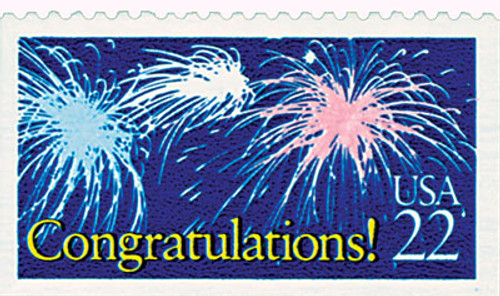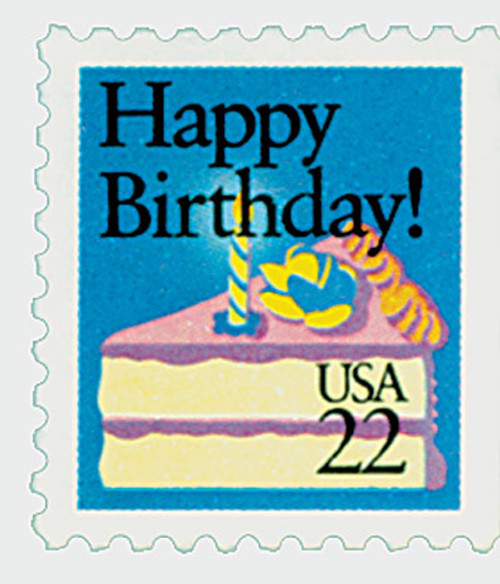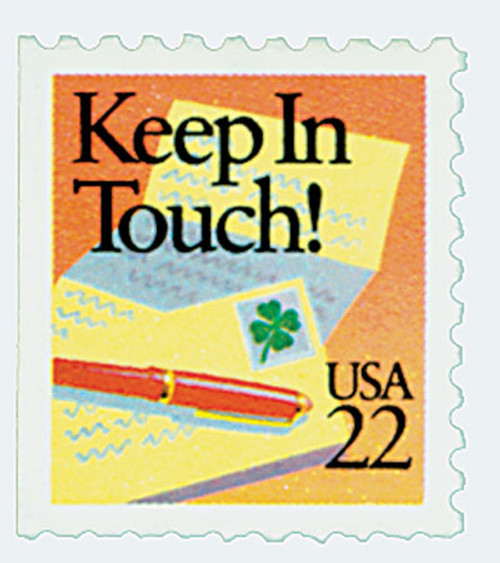
# 2270 - 1987 22c Special Occasions: Love You, Dad!
U.S. #2270
1987 22¢ Love You, Dad!
Special Occasions
- From first “special” stamp booklet, which would remain on sale longer than regular stamps
- From first US booklet to have the UPC bar code on the cover
- First US stamps to be specifically created for a specialized retail market and sold through card stores and florists
- From first US booklet to have stamps in three different configurations.
Stamp Category: Commemorative
Set: Special Occasions
Value: 22¢, first-class rate
First Day of Issue: April 20, 1987
First Day City: Atlanta, Georgia
Quantity Issued: 76,303,125
Printed by: Bureau of Engraving and Printing
Printing Method: Photogravure
Format: Booklet panes of 10
Perforations: 10 on 1, 2, or 3 sides
Why the stamp was issued: In response to calls for stamps that could frank mail for special occasions.
About the stamp design: The Special Occasions stamps were the first to be designed by Oren Sherman. He produced the designs based on messages provided by the Citizens’ Stamp Advisory Committee and the USPS. This stamp reads “Love You, Dad!” with a cup of coffee, glasses, and a crossword puzzle.
First Day City: During the planning process for these stamps, the USPS talked extensively about issuing them in May 1987 at the New York City trade show of a stationers’ group. However, as the date drew nearer, they realized that the trade show would take place after Mother’s Day, and with one of the stamps ideal for that holiday, they wanted to issue the booklet beforehand. So instead, they moved the ceremony to Atlanta, Georgia on April 20, 1987. Among those present for the ceremony was Martha Burke, National American Mother of the Year.
About the Special Occasions Set: For several years, the USPS received requests for stamps for special occasions such as Mother’s Day, Father’s Day, weddings, graduations, birthdays, and more. In the mid-1980s, the USPS began addressing these requests.
The Special Occasions booklet began with a single stamp. In 1985, the USPS announced it would issue a stamp to mark the 50th anniversary of American Mothers, Inc. in 1986. However, as they discussed the stamp and the public requests further, the idea grew into what they called the Messages booklet, and later the Special Occasions booklet.
As the USPS moved forward with the project, they did something they hadn’t done before. They started working with florists and the greeting card industry, trying to see if they would be interested in seeing these new stamps in their stores. The USPS encouraged them to poll their respective associations. They wanted to know if there would be interest in selling these stamps in their stores. If successful, the Special Occasions stamps could be sold in stationery stores, card shops, large supermarkets, and other non-postal outlets. And if the stamps were popular enough, they could be as big for the USPS as Love and Christmas stamps.
In September 1986, the final eight stamp designs were revealed at a meeting of the Greeting Card Association. It was announced that the booklets would have 10 stamps, with two of the designs (Congratulations and Happy Birthday) being repeated, selling for a total of $2.20. This was also the first US booklet to have the UPC (Universal Product Code) bar code on the cover.
When the stamps were released, the USPS said that they “classified them as special stamps because they would remain on sale longer than commemorative stamps.” The stamps were to remain on sale for the remainder of the year, making them the USPS’s first “special” stamp booklet. They were the first US stamps to be specifically created for a specialized retail market, the first to be sold through card stores and florists, and the first US booklet to have stamps in three different configurations.
History the stamp represents: Greeting cards date back to the ancient Chinese, who sent messages celebrating the New Year and the early Egyptians who sent messages on papyrus scrolls. Handmade greeting cards grew in popularity in Europe in the 1400s. For many years, greeting cards were expensive, but advancements in printing technology and the advent of postage stamps made sending the cards more affordable by the 1850s. Soon cards could be mass produced for occasions throughout the year.
Hallmark Cards, Inc., one of America’s largest greeting card manufacturers, was founded in 1910 by Joyce C. Hall. Previously, Hall had owned a small retail store, but after a captivating conversation with a travelling salesman, he narrowed his focus on postcards. Hall soon recognized that greeting cards would become more popular than postcards. He believed greeting cards “represented class, promised discretion and… were more than a form of communication – they were a social custom.”
History of Father’s Day
On June 19, 1910, one of the first Father’s Day celebrations was held at the YMCA in Spokane, Washington. It would be another 62 years before it was made a permanent national holiday.
Another of the first recorded US Father’s Day celebrations was held on July 5, 1908, in Fairmont, West Virginia. Grace Golden Clayton organized that event.
While Clayton mourned the death of her father in 1907, a mine exploded in nearby Monongah killing 361 men, 250 of whom were fathers. This disaster left about 1,000 children without fathers and Clayton spoke to her pastor about doing something to honor all of those fathers.
However, the event that Clayton planned did not become widespread because it was held on July 5, and was overshadowed by the Independence Day celebrations of July 4. Between the festivities and the sudden death of a young girl, the local church didn’t think to promote the event and it wasn’t held again for several years.
In the years that followed, there were other attempts to establish a Father’s Day. In 1911, Jane Addams suggested a Father’s Day celebration in Chicago, but her idea was rejected. And in 1912, Vancouver, Washington held a celebration of their own. Harry C. Meek of the Lions Club also claimed that he had come up with the idea for Father’s Day in 1915, stating that the third Sunday in June was selected because it was his birthday. The Lions Club calls him the Originator of Father’s Day.
However, many sources credit Spokane, Washington, as the originator of today’s Father’s Day. Their celebration was held on June 19, 1910, at the local YMCA. Sonora Smart Dodd, whose single father had raised her and five siblings on his own, planned the event. After hearing about the 1908 Mother’s Day festivities in West Virginia, she suggested to her pastor that they hold a similar event for fathers. Dodd initially suggested the event be held on June 5 to celebrate her father’s birthday, but the pastors didn’t have enough time to compose their sermons, so they decided to hold it on the third Sunday of June. On that day, pastors at several different churches around Spokane delivered sermons honoring fathers.
By 1913, a bill was introduced to Congress in support of the holiday. In 1916, President Woodrow Wilson visited Spokane to speak at the Father’s Day celebration. He tried to make it a federal holiday, but Congress opposed the idea out of fears it would be commercialized. Calvin Coolidge also suggested Father’s Day celebrations in 1924 but didn’t issue a national proclamation.
In the 1920s, Dodd started studying at the Art Institute of Chicago and the Father’s Day celebrations in Spokane ceased. When she returned in the 1930s, she began to promote it again, gaining national attention. Dodd gained the support of businesses that would most benefit from the holiday – makers of ties, tobacco pipes, and other traditional gifts for fathers. By 1938, the New York Associated Men’s Wear Retailers founded the Father’s Day Council to promote a unified holiday.
Many people opposed Father’s Day because they believed it was an attempt by businesses to recreate the commercial success of Mother’s Day. However, in 1957, Senator Margaret Chase Smith submitted another proposal for Father’s Day, accusing Congress of ignoring father’s for 40 years while honoring mothers and “ out just one of our two parents.” In 1966, President Lyndon Johnson gave the first presidential proclamation for fathers, calling for the third Sunday in June to be celebrated as Father’s Day. Then six years later, Richard Nixon made Father’s Day a permanent national holiday in 1972.
U.S. #2270
1987 22¢ Love You, Dad!
Special Occasions
- From first “special” stamp booklet, which would remain on sale longer than regular stamps
- From first US booklet to have the UPC bar code on the cover
- First US stamps to be specifically created for a specialized retail market and sold through card stores and florists
- From first US booklet to have stamps in three different configurations.
Stamp Category: Commemorative
Set: Special Occasions
Value: 22¢, first-class rate
First Day of Issue: April 20, 1987
First Day City: Atlanta, Georgia
Quantity Issued: 76,303,125
Printed by: Bureau of Engraving and Printing
Printing Method: Photogravure
Format: Booklet panes of 10
Perforations: 10 on 1, 2, or 3 sides
Why the stamp was issued: In response to calls for stamps that could frank mail for special occasions.
About the stamp design: The Special Occasions stamps were the first to be designed by Oren Sherman. He produced the designs based on messages provided by the Citizens’ Stamp Advisory Committee and the USPS. This stamp reads “Love You, Dad!” with a cup of coffee, glasses, and a crossword puzzle.
First Day City: During the planning process for these stamps, the USPS talked extensively about issuing them in May 1987 at the New York City trade show of a stationers’ group. However, as the date drew nearer, they realized that the trade show would take place after Mother’s Day, and with one of the stamps ideal for that holiday, they wanted to issue the booklet beforehand. So instead, they moved the ceremony to Atlanta, Georgia on April 20, 1987. Among those present for the ceremony was Martha Burke, National American Mother of the Year.
About the Special Occasions Set: For several years, the USPS received requests for stamps for special occasions such as Mother’s Day, Father’s Day, weddings, graduations, birthdays, and more. In the mid-1980s, the USPS began addressing these requests.
The Special Occasions booklet began with a single stamp. In 1985, the USPS announced it would issue a stamp to mark the 50th anniversary of American Mothers, Inc. in 1986. However, as they discussed the stamp and the public requests further, the idea grew into what they called the Messages booklet, and later the Special Occasions booklet.
As the USPS moved forward with the project, they did something they hadn’t done before. They started working with florists and the greeting card industry, trying to see if they would be interested in seeing these new stamps in their stores. The USPS encouraged them to poll their respective associations. They wanted to know if there would be interest in selling these stamps in their stores. If successful, the Special Occasions stamps could be sold in stationery stores, card shops, large supermarkets, and other non-postal outlets. And if the stamps were popular enough, they could be as big for the USPS as Love and Christmas stamps.
In September 1986, the final eight stamp designs were revealed at a meeting of the Greeting Card Association. It was announced that the booklets would have 10 stamps, with two of the designs (Congratulations and Happy Birthday) being repeated, selling for a total of $2.20. This was also the first US booklet to have the UPC (Universal Product Code) bar code on the cover.
When the stamps were released, the USPS said that they “classified them as special stamps because they would remain on sale longer than commemorative stamps.” The stamps were to remain on sale for the remainder of the year, making them the USPS’s first “special” stamp booklet. They were the first US stamps to be specifically created for a specialized retail market, the first to be sold through card stores and florists, and the first US booklet to have stamps in three different configurations.
History the stamp represents: Greeting cards date back to the ancient Chinese, who sent messages celebrating the New Year and the early Egyptians who sent messages on papyrus scrolls. Handmade greeting cards grew in popularity in Europe in the 1400s. For many years, greeting cards were expensive, but advancements in printing technology and the advent of postage stamps made sending the cards more affordable by the 1850s. Soon cards could be mass produced for occasions throughout the year.
Hallmark Cards, Inc., one of America’s largest greeting card manufacturers, was founded in 1910 by Joyce C. Hall. Previously, Hall had owned a small retail store, but after a captivating conversation with a travelling salesman, he narrowed his focus on postcards. Hall soon recognized that greeting cards would become more popular than postcards. He believed greeting cards “represented class, promised discretion and… were more than a form of communication – they were a social custom.”
History of Father’s Day
On June 19, 1910, one of the first Father’s Day celebrations was held at the YMCA in Spokane, Washington. It would be another 62 years before it was made a permanent national holiday.
Another of the first recorded US Father’s Day celebrations was held on July 5, 1908, in Fairmont, West Virginia. Grace Golden Clayton organized that event.
While Clayton mourned the death of her father in 1907, a mine exploded in nearby Monongah killing 361 men, 250 of whom were fathers. This disaster left about 1,000 children without fathers and Clayton spoke to her pastor about doing something to honor all of those fathers.
However, the event that Clayton planned did not become widespread because it was held on July 5, and was overshadowed by the Independence Day celebrations of July 4. Between the festivities and the sudden death of a young girl, the local church didn’t think to promote the event and it wasn’t held again for several years.
In the years that followed, there were other attempts to establish a Father’s Day. In 1911, Jane Addams suggested a Father’s Day celebration in Chicago, but her idea was rejected. And in 1912, Vancouver, Washington held a celebration of their own. Harry C. Meek of the Lions Club also claimed that he had come up with the idea for Father’s Day in 1915, stating that the third Sunday in June was selected because it was his birthday. The Lions Club calls him the Originator of Father’s Day.
However, many sources credit Spokane, Washington, as the originator of today’s Father’s Day. Their celebration was held on June 19, 1910, at the local YMCA. Sonora Smart Dodd, whose single father had raised her and five siblings on his own, planned the event. After hearing about the 1908 Mother’s Day festivities in West Virginia, she suggested to her pastor that they hold a similar event for fathers. Dodd initially suggested the event be held on June 5 to celebrate her father’s birthday, but the pastors didn’t have enough time to compose their sermons, so they decided to hold it on the third Sunday of June. On that day, pastors at several different churches around Spokane delivered sermons honoring fathers.
By 1913, a bill was introduced to Congress in support of the holiday. In 1916, President Woodrow Wilson visited Spokane to speak at the Father’s Day celebration. He tried to make it a federal holiday, but Congress opposed the idea out of fears it would be commercialized. Calvin Coolidge also suggested Father’s Day celebrations in 1924 but didn’t issue a national proclamation.
In the 1920s, Dodd started studying at the Art Institute of Chicago and the Father’s Day celebrations in Spokane ceased. When she returned in the 1930s, she began to promote it again, gaining national attention. Dodd gained the support of businesses that would most benefit from the holiday – makers of ties, tobacco pipes, and other traditional gifts for fathers. By 1938, the New York Associated Men’s Wear Retailers founded the Father’s Day Council to promote a unified holiday.
Many people opposed Father’s Day because they believed it was an attempt by businesses to recreate the commercial success of Mother’s Day. However, in 1957, Senator Margaret Chase Smith submitted another proposal for Father’s Day, accusing Congress of ignoring father’s for 40 years while honoring mothers and “ out just one of our two parents.” In 1966, President Lyndon Johnson gave the first presidential proclamation for fathers, calling for the third Sunday in June to be celebrated as Father’s Day. Then six years later, Richard Nixon made Father’s Day a permanent national holiday in 1972.















